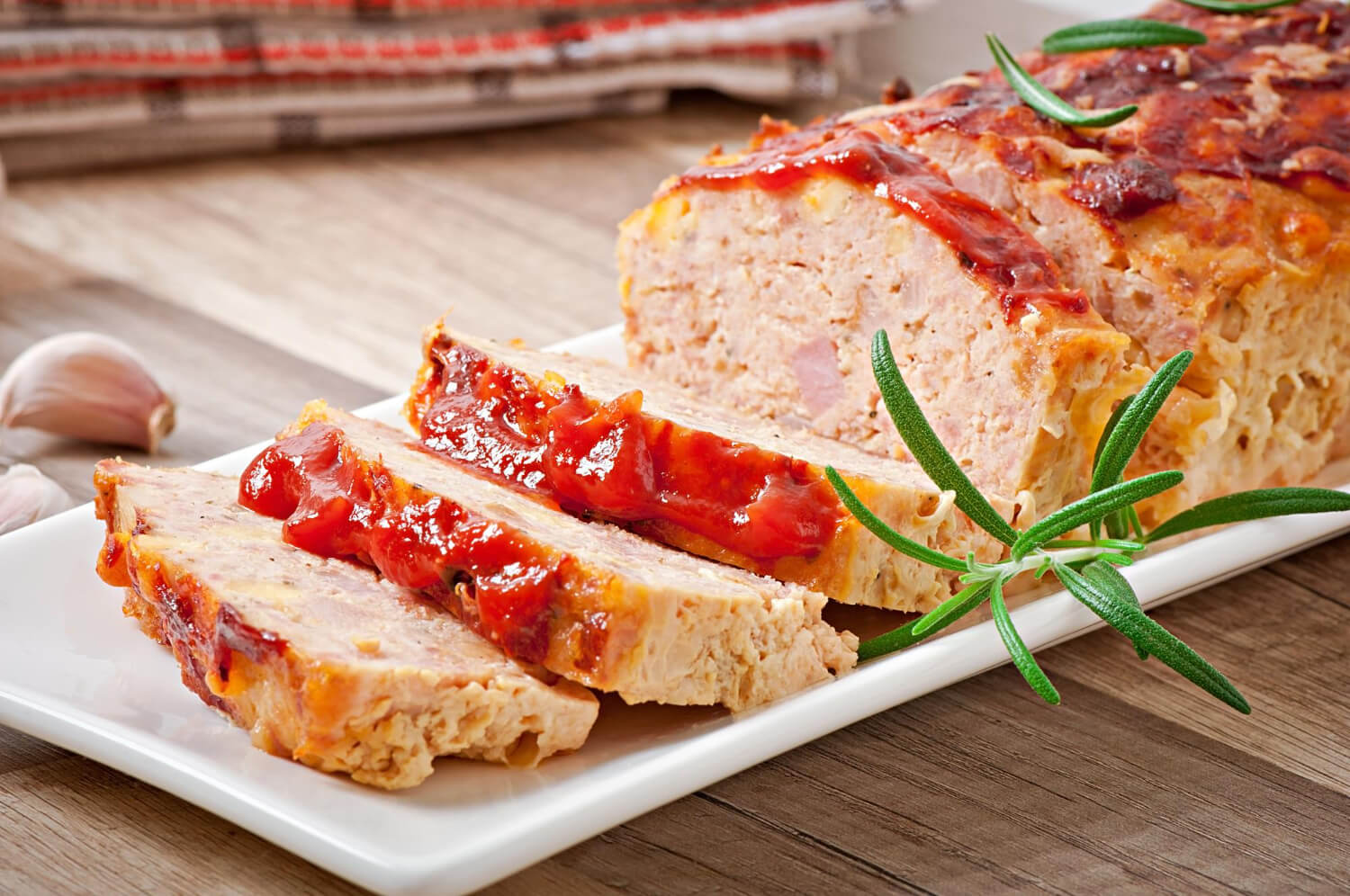Introduction
There’s nothing quite as comforting as a homemade meatloaf, fresh out of the oven, with its savory aroma filling the kitchen. This classic dish has been a family favorite for generations, offering a blend of hearty flavors and textures. But as simple as meatloaf seems, one key question remains: What is the secret to juicy meatloaf?
Achieving the perfect balance of moisture and flavor can turn a humble meatloaf into a culinary masterpiece. Yet, many cooks struggle with common pitfalls like dryness or crumbling, which can rob this dish of its signature appeal. Whether you’re cooking for a weekday dinner or a special gathering, learning the secrets to a juicy meatloaf can transform your mealtime experience.
In this guide, we’ll uncover tips and techniques to ensure your meatloaf stays tender and flavorful every time. From using moisture-rich ingredients to following tried-and-true recipes like the Lipton Onion Soup Mix Meatloaf, you’ll discover actionable steps to elevate your cooking. We’ll also answer frequently asked questions, such as whether to cook onions beforehand or why milk is preferred over water.
Get ready to unlock the secrets that will make your meatloaf the star of any meal!
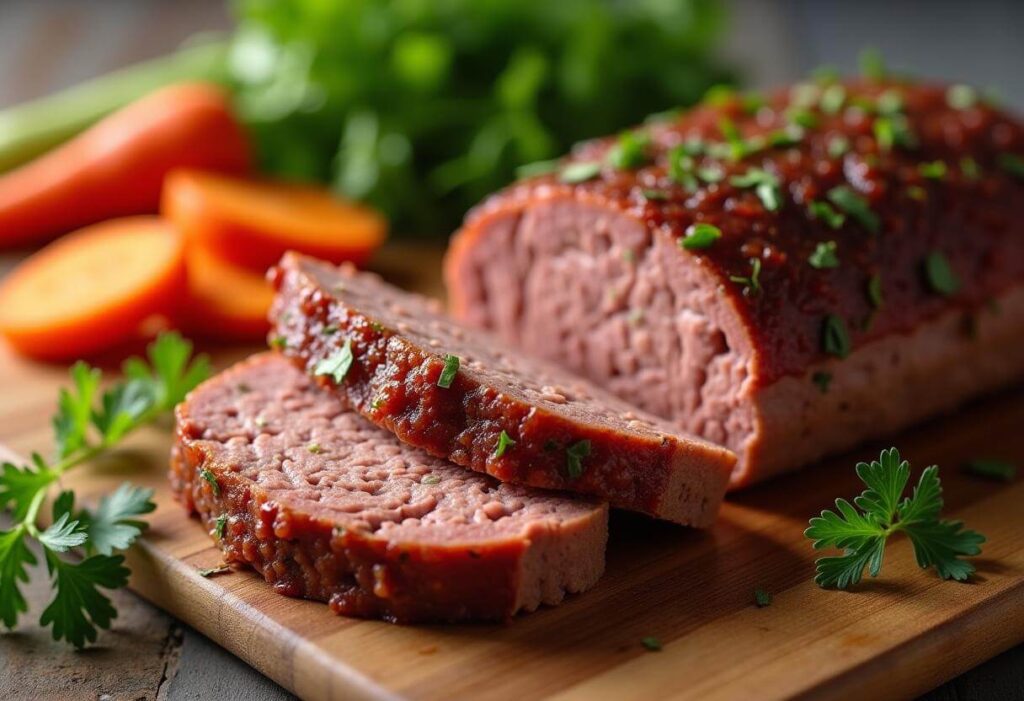
Part 1: Why is Meatloaf So Popular?
Meatloaf is more than just a meal—it’s a symbol of comfort and tradition. This beloved dish has graced dinner tables for centuries, originating from frugal cooking practices where families combined ground meat with inexpensive fillers like breadcrumbs. Over time, it evolved into a staple in homes worldwide, offering both nourishment and nostalgia.
What makes meatloaf so popular is its incredible versatility. It can be adapted to suit any occasion, whether it’s a simple weekday dinner or a centerpiece for a family gathering. From classic recipes featuring ground beef and ketchup glaze to modern variations with gourmet twists like bacon or cheese, meatloaf caters to all tastes and preferences.
However, the true hallmark of a great meatloaf lies in its texture. A perfectly juicy meatloaf elevates the dish from ordinary to extraordinary. Achieving that ideal level of moisture ensures every bite is tender, flavorful, and satisfying. Dry or crumbly meatloaf, on the other hand, falls short of its comforting reputation.
This enduring popularity shows that meatloaf isn’t just a meal—it’s a cherished tradition. And learning how to make it juicy and delicious ensures this classic dish will continue to be a family favorite for generations to come.
Part 2: What is the Secret to Juicy Meatloaf?
So, what is the secret to juicy meatloaf? The answer lies in a few essential techniques and ingredient choices that make all the difference. With these secrets, your meatloaf will come out tender, moist, and packed with flavor every time.
1. Use Fat-Rich Meats
One of the primary keys to a juicy meatloaf is choosing the right combination of meats. Lean meat alone often results in dryness, as it lacks the fat needed for moisture. For the best results, blend ground beef (80% lean) with ground pork or veal. The added fat content enhances the flavor and ensures every bite is tender. If you’re using turkey or chicken, consider adding extra moisture-rich ingredients to compensate for the lower fat content.
2. Avoid Overmixing
While it’s tempting to mix everything thoroughly, overhandling the meat can lead to a dense, tough loaf. Mix the ingredients just enough to combine them. A gentle hand preserves the airy texture that makes a meatloaf enjoyable. Think of it as folding the ingredients together rather than kneading them.
3. Include Moisture-Rich Ingredients
To keep your meatloaf moist, it’s important to incorporate ingredients that retain water during cooking. Milk, eggs, and ketchup are some of the best choices. Milk not only softens breadcrumbs but also adds richness. Eggs act as a binder while contributing creaminess, and ketchup not only adds tangy sweetness but also locks in moisture. If you’re feeling adventurous, try adding grated vegetables like carrots or zucchini—they release water as they cook, keeping the meatloaf succulent.
4. The Magic of Breadcrumbs
Breadcrumbs play a crucial role in holding the meatloaf together while maintaining its tender texture. For an extra layer of juiciness, soak your breadcrumbs in milk before mixing them into the meat. This step ensures the breadcrumbs absorb and retain moisture, preventing the meatloaf from drying out. You can also use alternatives like crushed crackers or panko for a unique twist.
By following these simple yet effective tips, you’ll unlock the secret to a juicy meatloaf that’s sure to impress. From the fat content in the meat to the magic of milk-soaked breadcrumbs, every detail matters in achieving that perfect bite.
Part 3: Lipton Onion Soup Mix – A Game-Changer for Juicy Meatloaf
When it comes to meatloaf recipes, the Old Fashioned Meatloaf Recipe with Lipton Onion Soup Mix stands out as a timeless favorite. This recipe has been passed down through generations, praised for its simplicity and the unbeatable flavor it delivers. The addition of Lipton Onion Soup Mix transforms an ordinary meatloaf into a savory masterpiece.
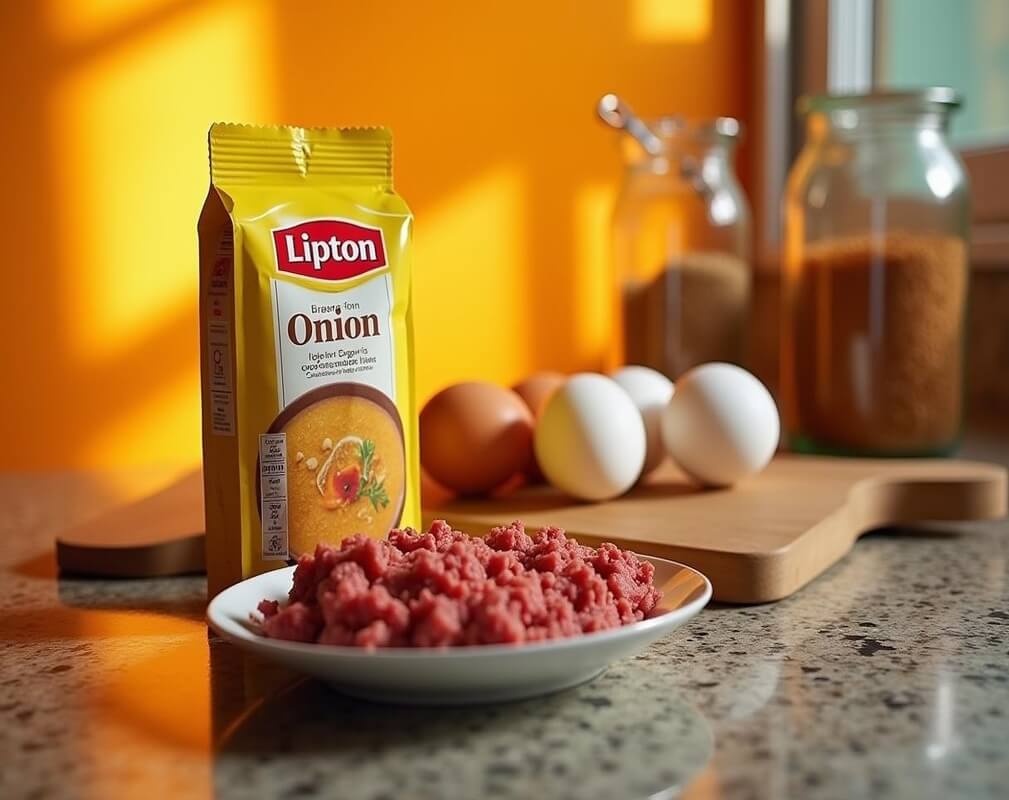
Why Lipton Onion Soup Mix?
The secret lies in the soup mix’s perfect blend of dried onions, herbs, and seasonings. These ingredients infuse the meatloaf with rich, savory flavors that require no additional effort. The onion mix acts as both a seasoning and an aromatic, eliminating the need to chop fresh onions while ensuring consistent taste every time.
The result? A meatloaf that’s full of depth and umami, making it a favorite among cooks seeking Lipton meatloaf recipe best results. Plus, it’s incredibly convenient, making it an ideal choice for busy weeknights or when you need an easy meatloaf recipe Lipton onion soup.
Quick Recipe: Lipton Onion Soup Mix Meatloaf
Here’s a simple and delicious way to make meatloaf using Lipton Onion Soup Mix:
Ingredients:
- 2 pounds ground beef
- 1 envelope Lipton Onion Soup Mix
- 2 eggs, lightly beaten
- 1/2 cup ketchup
- 3/4 cup breadcrumbs (soaked in 1/2 cup milk)
- 1 tablespoon Worcestershire sauce
Instructions:
- Preheat your oven to 375°F (190°C).
- In a large bowl, combine the ground beef, Lipton Onion Soup Mix, eggs, breadcrumbs, milk, ketchup, and Worcestershire sauce. Mix gently until just combined.
- Shape the mixture into a loaf and place it in a greased baking dish.
- Bake for 50-60 minutes or until the internal temperature reaches 160°F (71°C).
- Let the meatloaf rest for 10 minutes before slicing.
This recipe captures the heart of a classic meatloaf while highlighting the convenience and flavor boost of Lipton Onion Soup Mix. Once you try it, you’ll see why it’s a game-changer!
Part 4: Step-by-Step Recipe for the Juiciest Meatloaf
Creating the perfect meatloaf requires a balance of ingredients, technique, and a touch of patience. This step-by-step guide will walk you through an easy-to-follow recipe that’s guaranteed to result in a juicy and flavorful loaf.
Ingredients
Here’s what you’ll need for a classic meatloaf:
- 2 pounds ground beef (80% lean)
- 1 envelope Lipton Onion Soup Mix
- 3/4 cup breadcrumbs
- 1/2 cup milk (for soaking breadcrumbs)
- 2 eggs, lightly beaten
- 1/2 cup ketchup
- 1 tablespoon Worcestershire sauce
- Optional: 1/4 cup finely grated carrots or zucchini (for added moisture)
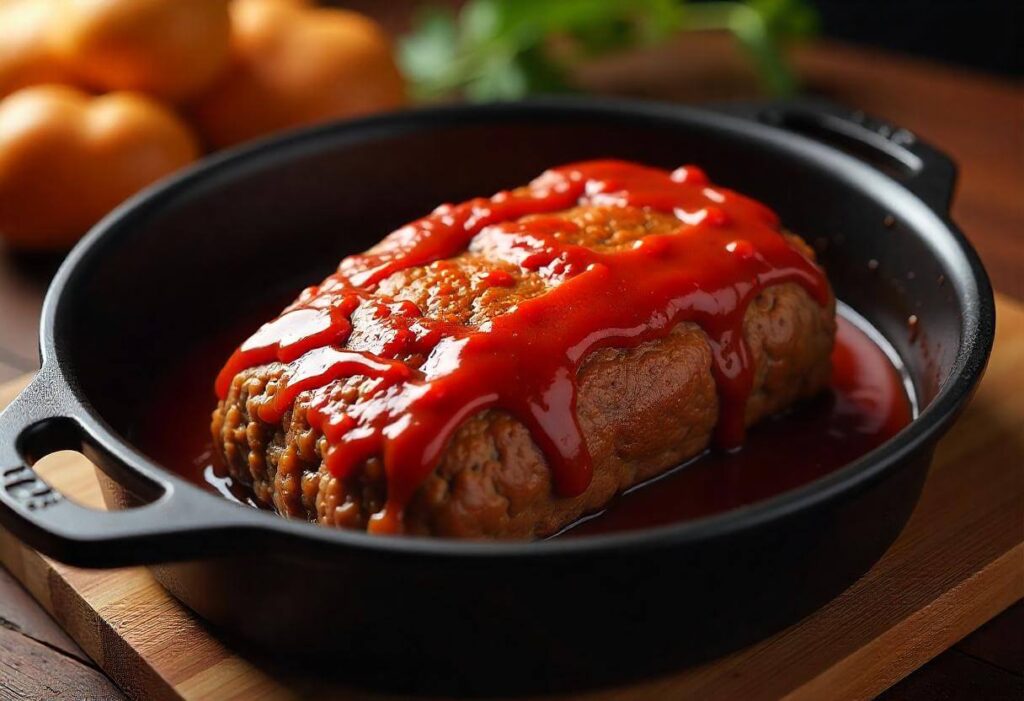
Cooking Method
- Prepare the Breadcrumb Mixture
- Start by soaking the breadcrumbs in milk for about 5 minutes. This step ensures the breadcrumbs stay moist and tender during baking, preventing the meatloaf from drying out.
- Why milk instead of water in meatloaf? Milk adds richness and creaminess that water simply cannot provide. It softens the breadcrumbs while enhancing the overall flavor.
- Combine the Ingredients
- In a large mixing bowl, combine the ground beef, Lipton Onion Soup Mix, soaked breadcrumbs, eggs, ketchup, Worcestershire sauce, and any optional vegetables.
- Mix gently until just combined to avoid overworking the meat, which can make the meatloaf dense.
- Shape and Bake
- Preheat your oven to 375°F (190°C).
- Shape the meat mixture into a loaf and place it in a lightly greased baking dish. You can also use a loaf pan for a more uniform shape.
- Bake for 50–60 minutes or until the internal temperature of the meatloaf reaches 160°F (71°C). Use a meat thermometer for accuracy.
- Rest and Serve
- Allow the meatloaf to rest for 10 minutes after removing it from the oven. Resting locks in the juices and makes slicing easier.
Tips for Juicy Results
- Temperature control is key: Cooking at 375°F provides enough heat to cook through without drying the meat.
- Don’t skip the milk: It plays a dual role by tenderizing the breadcrumbs and adding a creamy, luscious texture to the meatloaf.
This recipe is a foolproof way to achieve a meatloaf that’s both delicious and perfectly moist. Serve with mashed potatoes or roasted vegetables for a complete meal!
Part 5: Avoiding Mistakes for Juicy Meatloaf Success
Even with the best intentions, meatloaf can sometimes fall short of expectations. Whether it turns out too dry, tough, or bland, these common mistakes can easily derail your efforts. Here’s what to watch out for—and how to fix it.
1. Skipping the Resting Step
One of the most overlooked steps is allowing the meatloaf to rest after baking. Cutting into it immediately causes the juices to escape, leaving the loaf dry and crumbly.
Solution: After removing the meatloaf from the oven, let it rest for at least 10 minutes. This allows the juices to redistribute, keeping the loaf moist and easy to slice.
2. Cooking at High Temperatures
High heat might seem like a way to speed things up, but it often results in a tough, overcooked exterior and undercooked interior.
Solution: Stick to a moderate oven temperature, such as 375°F (190°C). This ensures even cooking without drying out the meat. Using a meat thermometer to check for an internal temperature of 160°F (71°C) is the best way to avoid overcooking.
3. Skimping on Seasonings
A bland meatloaf is a missed opportunity to showcase bold, comforting flavors. Without enough seasoning, the dish can taste flat and uninspired.
Solution: Be generous with seasonings like Worcestershire sauce, garlic powder, and the Lipton Onion Soup Mix. These ingredients add depth and enhance the natural flavors of the meat. Consider adding a glaze of ketchup or barbecue sauce on top for extra flavor.
Bonus Tip: Avoid Overmixing
Overworking the mixture can lead to a dense, rubbery texture.
Solution: Mix the ingredients just until combined to keep the loaf tender and light.
By addressing these common pitfalls and following these tips, you’ll avoid the mistakes that can ruin a meatloaf and ensure a perfectly juicy result every time.
Part 6: FAQ – Perfecting Your Meatloaf
Should you cook onions before adding to meatloaf?
Yes, cooking onions before adding them to meatloaf is highly recommended. Sautéing onions softens their texture and enhances their natural sweetness, which blends seamlessly into the meat mixture. This step also eliminates the sharp bite of raw onions, making the overall flavor smoother and more cohesive.
However, there are instances when raw onions might be acceptable. If you enjoy a bit of crunch and sharper flavor in your meatloaf, finely diced raw onions can be added directly to the mixture. Just be sure to dice them small enough to cook thoroughly during baking.
What is the basic meatloaf formula?
The basic formula for meatloaf is simple and versatile:
- 1 pound of ground meat
- 1 egg (for binding)
- 1 cup of breadcrumbs (to retain moisture)
From this foundation, you can create endless variations. For example, you can substitute breadcrumbs with crushed crackers or oatmeal. Add-ins like grated carrots, shredded cheese, or Worcestershire sauce can elevate the flavor profile. Using a glaze of ketchup, barbecue sauce, or mustard on top can also add a delicious finishing touch.
Why milk instead of water in meatloaf?
Milk is an essential ingredient in meatloaf because it tenderizes breadcrumbs, creating a soft, cohesive texture. Unlike water, milk adds a creamy richness that enhances the overall flavor of the dish. Soaked breadcrumbs act like a sponge, holding onto moisture and releasing it as the meatloaf cooks, ensuring every slice is juicy and tender.
If you’re out of milk or prefer a dairy-free option, alternatives like unsweetened almond milk or broth can work, though they may not provide the same creamy depth as milk.
By understanding these foundational elements, you’ll be well-equipped to perfect your meatloaf every time!
Part 7: Original Lipton Onion Soup Meatloaf Recipe
The Original Lipton Onion Soup Meatloaf Recipe has stood the test of time, becoming a classic go-to for home cooks everywhere. Its simplicity, bold flavor, and easy preparation make it a perfect choice for busy weeknights or family dinners. With just a few ingredients, you can create a hearty, juicy meatloaf that’s bursting with savory goodness.
Classic Recipe
Ingredients:
- 2 pounds ground beef
- 1 envelope Lipton Onion Soup Mix
- 3/4 cup breadcrumbs
- 2 eggs, lightly beaten
- 1/3 cup ketchup
- 3/4 cup water
Instructions:
- Preheat your oven to 375°F (190°C).
- In a large bowl, combine the ground beef, Lipton Onion Soup Mix, breadcrumbs, eggs, ketchup, and water. Mix gently until just combined.
- Shape the mixture into a loaf and place it in a greased baking dish or loaf pan.
- Bake for 50–60 minutes, or until the internal temperature reaches 160°F (71°C).
- Let the meatloaf rest for 10 minutes before slicing.
Modern Tweaks
While the original recipe is a crowd-pleaser, you can customize it to suit your taste:
- Add shredded cheese to the mixture for a melty surprise.
- Brush barbecue sauce or a tangy glaze over the top before baking.
- Mix in finely chopped vegetables like carrots or zucchini for added nutrition and moisture.
This timeless recipe is perfect as-is or as a base for your own creative twists. Either way, it’s sure to become a staple in your recipe collection!
Part 8: Final Tips for Juicy Meatloaf
Making a perfectly juicy meatloaf is all about paying attention to the details. Let’s recap the key tips that will ensure your meatloaf turns out moist, flavorful, and irresistible every time:
- Choose fat-rich meats: Combine ground beef with pork or veal for added flavor and moisture.
- Incorporate moisture-rich ingredients: Soaked breadcrumbs, milk, eggs, and condiments like ketchup or Worcestershire sauce lock in juiciness.
- Avoid overmixing: Gently combine the ingredients to prevent a dense, tough texture.
Serving Suggestions
The beauty of meatloaf lies in its versatility. Pair your meatloaf with comforting sides like creamy mashed potatoes, roasted vegetables, or even a crisp green salad. For an extra indulgence, serve it with gravy or a tangy barbecue glaze.
Experiment with Flavors
One of the joys of meatloaf is its adaptability. Feel free to get creative with add-ins like shredded cheese, fresh herbs (parsley, thyme, or oregano), or finely chopped vegetables for extra texture and nutrition. A topping of sweet chili sauce or honey mustard can give your meatloaf a unique twist.
By combining these techniques with your favorite flavors, you’ll transform your meatloaf into a dish that everyone at the table will love. The possibilities are endless, so don’t be afraid to experiment and make it your own!
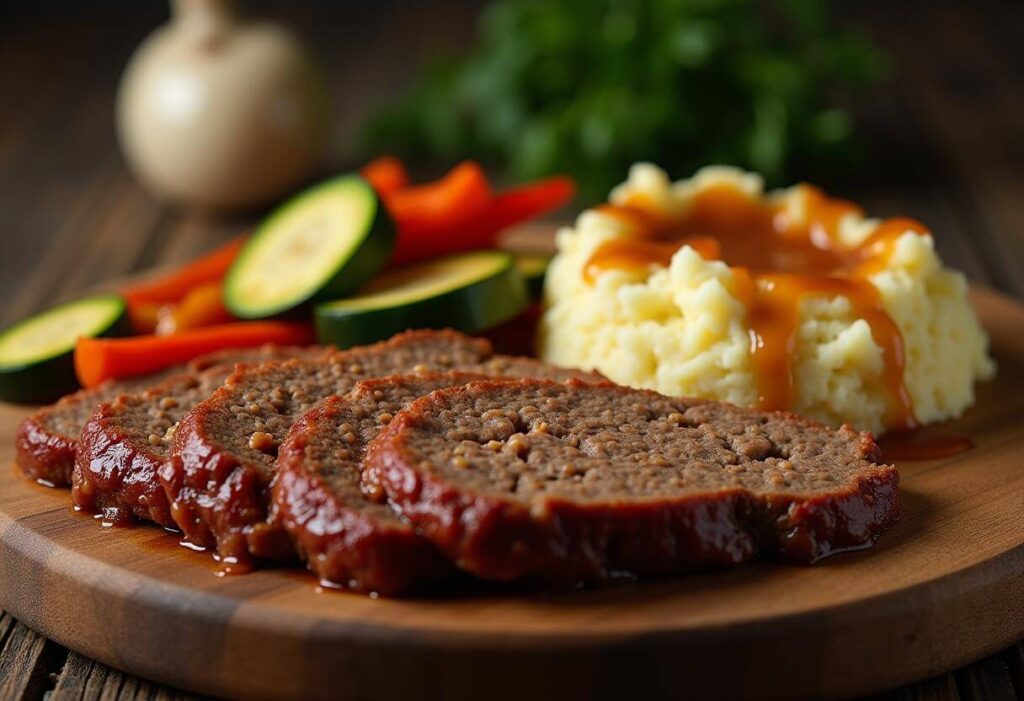
Conclusion
Achieving a perfectly juicy meatloaf is no longer a mystery. With the right techniques and ingredients, you can create a dish that’s tender, flavorful, and sure to become a family favorite. What is the secret to juicy meatloaf? It’s all about choosing fat-rich meats, incorporating moisture-rich ingredients like milk-soaked breadcrumbs, and mixing gently to maintain a light texture.
Recipes like the Original Lipton Onion Soup Meatloaf provide a delicious starting point, and modern tweaks let you customize the dish to suit your tastes. Whether you stick to the classics or get creative with add-ins like cheese and herbs, the key is balancing flavor and moisture for a satisfying result.
Now it’s your turn! Try the tips and recipes shared here, and watch your meatloaf game soar to new heights. Serve it with your favorite sides, experiment with glazes, and don’t forget to let it rest before slicing to lock in all the juices.
We’d love to hear from you. Share your favorite meatloaf secrets in the comments—whether it’s a unique ingredient, a clever technique, or a family recipe. Let’s keep the tradition of this comforting dish alive and thriving!

